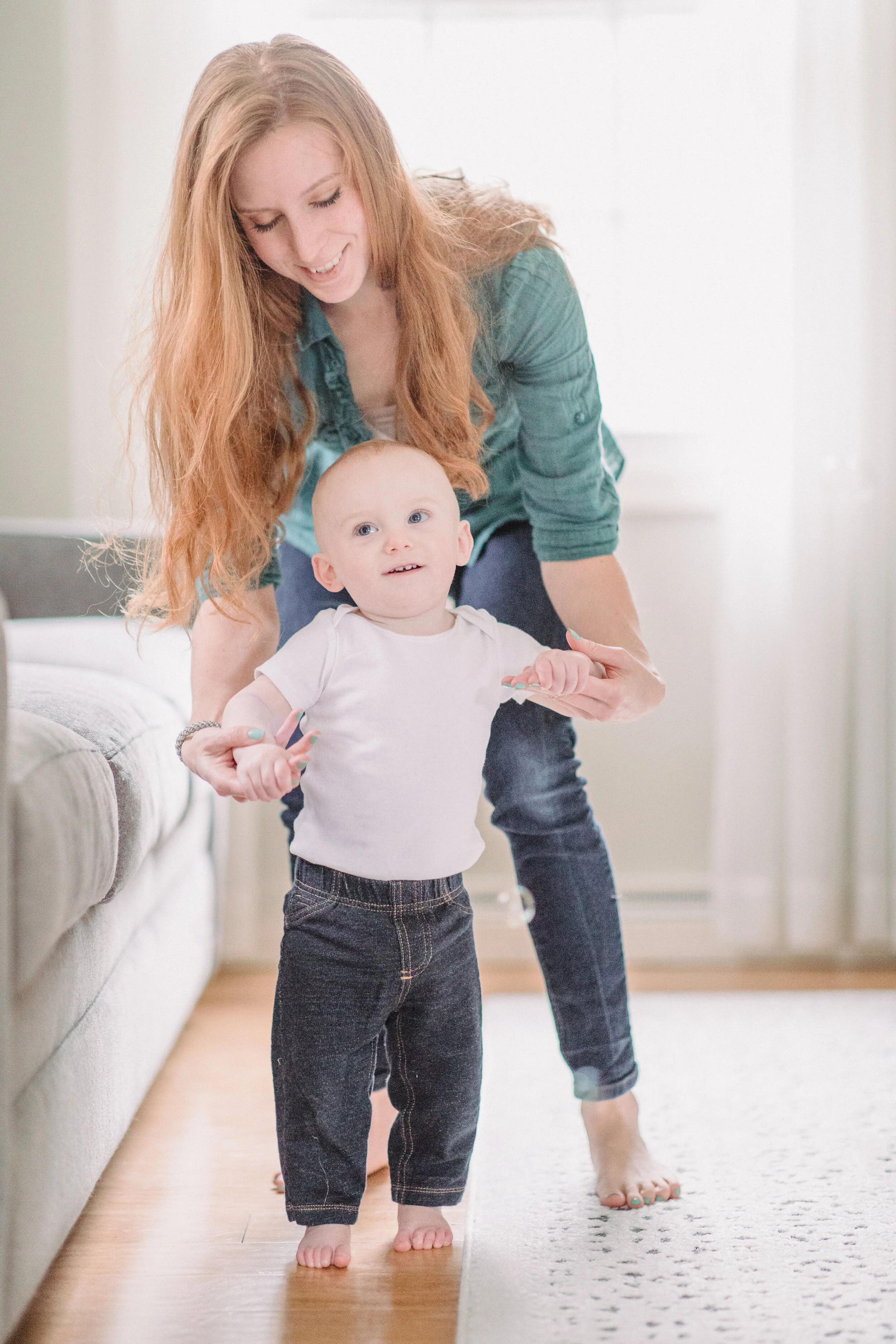Why proper preparation for walking is important
Most parents are dying to celebrate first steps, but don’t rush it! It is important for your baby to master the foundational skills for walking to support good balance and coordination later. Babies need to progress through motor skills to master them and then build on them. Strength and endurance are gained through play in preparatory positions like kneeling, squatting, cruising, or walking behind a push toy. Play ideas are waiting down below!
Read more on the science behind first steps below.
Top 5 play positions to prepare for walking
Kneeling (playing on knees with bum up off of the heels)
Stepping into standing (usually at a couch or holding onto something in front of them)
Squatting
Cruising (walking sideways while holding onto furniture or wall)
Using a push toy
Play in kneeling
The goal here is to get baby to play in kneeling but move into tall kneeling (like this pic) with bum off the heels. This strengthens the buns and hips for being able to step into standing and take steps.
Pull a couch cushion or two onto the floor. Place an interesting toy onto the couch cushions on the floor. Raising the toy height causes baby to have to get their bum up off of their feet to reach for the toy.
Try using a ring sacker, shape sorter, puzzle, or another toy with lots of pieces. Place the pieces up high on the couch and the shape sorter bucket or other piece on the floor to make baby repeat the movement of tall keeling (bum off the feet) and then going back down to the floor.
Play at the ottoman, couch or coffee table and help baby step up from kneeling into standing. Place toys up on the couch, just out of baby’s reach to one side and encourage him/her to reach for the toy. The reaching will cause baby to put more weight into the foot on that side (therapy term is weight shift) and step up into standing. Repeat several times to both sides evenly.
Stepping into standing
Place baby straddle sitting over one of your legs, facing you. Put one of their knees on the floor and the other leg's foot flat on the floor. Now make silly faces, blow bubbles, entice them to stand up to come give you a kiss.
Squatting
Place baby’s favorite toys (puzzle board) up on the couch or ottoman. Place the pieces down on the floor on both sides of baby. Motivate baby to squat down and get the piece and then return to standing to put the piece in the board. Picking toys with lots of pieces is great for this task to increase the repetition.
Try this at a slider or glass storm door, or even a mirror. Use suction cup balls or Squigs (both linked in bold) on the glass. Stick them up there (wet works best) and have baby pull them off and put them in your hand. This increase standing time, balance as they work to pull it off and increase motivation to squat repeatedly.
Cruising/side-stepping:
Playing in standing gives baby time to build strength, endurance and find their balance when upright.
When baby is standing, place favorite toys just out of reach on the couch surface. This will cause them to reach and shift their weight to reach - a pre-sidestepping skill they'll need before they can walk.
Play at a mirror, sliding glass door, or refrigerator. Use window clings, window stickers, suction cups or magnets to encourage baby to reach and move side to side once he/she is standing at the mirror or door. Move the items further away as your baby starts to take side steps (cruise). This strengthens the hips and trunk muscles to support walking.
Walking with push toy:
If you have one available, use a walker toy (the kind that baby stands behind and pushes like a cart). Try weighing it down with a wrist weight on the handle or water bottles/canned goods in the basket. Unweighted carts/walkers tend to get too far ahead of baby as he/she is learning. Slow and controlled is the goal.
Or, hold the broomstick horizontally in front of baby so they have something to hold onto for balance and you can work on the same skills. You face baby and walk backwards as they takes steps, keeping the broom handle about 1in lower than baby’s shoulders.
You can always walk and hold baby’s hands but try tpo keep their hands at a level like they are pushing a grocery cart. When parents walk behind baby with baby’s arms extended straight above their heads, it changes baby’s balance and the way they step.
We hope you have fun playing with your baby to prepare for those much anticipated first steps! Make sure you tag us on Instagram with questions and successes! We love to problem solve and see your little ones playing and getting stronger!
Stay up to date and share our tips with friends at
-Bree
We’re Jaclyn & Bree
Pediatric therapists and moms with a mission to empower you with knowledge to encourage your baby’s development and continue confidently into your parenthood journey.
If you have any questions, please feel free to leave a comment below and we will get back to you. As always, the information we share is meant to provide general education and tips and is not intended as medical advice. If you have a specific question or concern about your child’s development, please speak directly to your child’s doctor or therapist.





